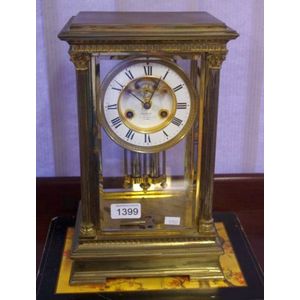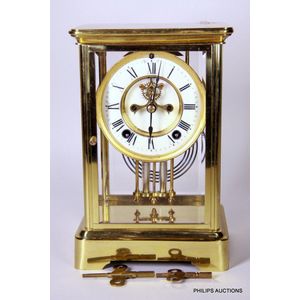French Brass Four-Glass Mantel Clock by S. Marti et Cie
You must be a subscriber, and be logged in to view price and dealer details.
Subscribe Now to view actual auction price for this item
When you subscribe, you have the option of setting the currency in which to display prices to $Au, $US, $NZ or Stg.
- Movement - The technical name for the workings of a clock or watch, and does not include the dial or case.
- Chapter Ring - A separate metal plate on the face of a clock, on which the numerals for the hours and sometimes parts of the hours, are displayed, usually wheel shaped and sitting on top of the dial plate. The chapter ring is often a feature of the clock and can be silvered or enamelled to stand as a contrast to its background. The hours are usually shown in Roman numerals, although in the late 19th and earlt 20th century, Arabic numerals became fashionable.
- Pendulum - The pendulum was discovered around 1602 by Galileo Galilei, and was adopted for time keeping by the Dutch mathematician and natural philosopher, Christiaan Huygens, who excelled in astronomy, physics, and horology.
The pendulum comprises a metal rod usually of brass or steel with a metal disk, known as a bob, at the end. The movement of the pendulum is driven by weights or a spring, and as a pendulum swings in a regular arc, it was found accuracy could be controlled to within a few seconds a week.
Timekeeping can be adjusted by changing the height of the bob on the rod, making the pendulum either swing slower or faster.
The disadvantage of the pendulum was that changes in temperature also changed the length of the pendulum, interfering with the accuracy of the clock, and so in the 18th century two types of mercurial pendulums were invented which countered the movement in the steel rod.
The pendulum was the world's most accurate timekeeping technology until the invention of the quartz clock, regulated by a quartz crystal, in 1927.
This item has been included into following indexes:
Visually similar items

S Matto brass four glass panel mantel clock with visible escapment, damage to one glass chamber, with a key. Height 30 cm

French 4-glass table regulator, with mercury temperature compensation pendulum marked Ch. Vcne (Chemin de Vincennes?) Dial marked E White of 20 Cockspur st. London

French Medaille de Bronze mantle clock, with 8 day movement, in marble and slate case (some chips), movement striking has been removed, key and pendulum included, 33 x 14 cm

An American Ansonia four glass brass mantle clock, early 20th century, the carriage style eight day clock having a Roman numeral chapter ring dial, subsidiary dial and visible escapement, with a mercury regulator pendulum; with key, height 25 cm, width 16
